|
Location: Cairo, Egypt. |
Grid Reference:
29� 58' 51"
N.
31� 8' 15"
E |
 The Giza Plateau:
('Ghiza', 'Geeza').
The Giza Plateau:
('Ghiza', 'Geeza').
(Scroll down for more..)
|
The Giza Plateau: Who built it and When. |
The Giza plateau is one of the most enduring
prehistoric monuments in the world. It is home to the three great
pyramids ( Those of Khufu, Khafre and Menkaure),
and at least six others as well as several other prominent
structures including the great Sphinx and the Valley temple.

(Satellite
map of Ghiza complex)
How old is Giza?
R ecent Carbon-14 dating results
indicate a period of construction from between 3,800 and 2,800 BC
(2), a
time-frame which is considerably earlier than is currently claimed by
Egyptologists
(Official estimates still vary from year to year around the region of
2,650 to 2,450 BC). If these
dates are confirmed in future sample-testing, Egyptologists will be forced
to consider the re-appraisal for the dates ascribed to 'Proto-dynastic',
'Pre-dynastic' and Early Dynasty cultures (As suggested by Manetho, Petrie,
Lockyer and others).
The 1984 "David H. Koch Pyramids
Radiocarbon Project" took organic material from several places in the
core of the Great Pyramid as well as other 4th Dynasty pyramids and
locations so as to try and date their radiocarbon. This yielded results
averaging 374 years earlier than the date accepted by egyptologists but
much more recent than 10,000 years ago. A second dating in 1995 with new
but similar material obtained dates ranging between 100-400 years
earlier than those indicated by the historic record. This raised
interesting questions concerning the origin and date of the wood.
Massive quantities of wood were used and burned, so to reconcile the
earlier dates the authors of the study theorize that possibly "old wood"
was used, assuming that wood was harvested from any source available,
including old construction material from all over Egypt. It is also
known that King Sneferu imported wood from Lebanon. Project scientists
based their conclusions on the evidence that some of the material in the
3rd Dynasty pyramid of Pharaoh Djoser and other monuments had been
recycled, concluding that the construction of the pyramids marked a a
major depletion of Egypt's exploitable wood. Dating of more short-lived
material around the pyramid (cloth, small fires, etc) yielded dates
nearer to those indicated by historical records. The authors insist more
evidence is need to settle this issue.
(Archaeology "
Dating the Pyramids " Volume 52 Number 5, September/October 1999)
This study does not sufficiently
address key anomalies in its findings, however - mainly how and where
the Egyptians were able to obtain literally tons of 100-400 year old
dead wood. Even preserved in a desert climate, finding forests of such
magnitude comprised of ancient dead wood would be a phenomenon in and of
itself. It is believed Egypt's climate would have only been able to
support such a forest (though there is no evidence of one having existed
at the time being largely grasslands) at the latest only prior to
4,000-6,000 BC. For this to be true an entire revision of Egypt's
climatic history would be required. When considering the data, what is
shown is the radio carbon of the pyramids yielded dates ranging from
100-400 years earlier than the "historical record", yet the signs of
last casual occupation, ie. cloth, small fires, etc, have given dates
much closer to what is expected from egyptologists. Instead of requiring
a revision of Egypt's climatic history based solely on the fact these
dates do not support accepted theory despite supporting climatology data
to the contrary, it is equally possible that what the study suggests is
true--that the pyramids are indeed older (if only by 100-400 years) than
what is currently believed.
Ref: (http://wikipedia.org)
|
Discoveries at Ghiza from before the 4th dynasty.
The earliest monument at Giza is 'mastaba V' , which dates to the reign
of the first dynasty pharaoh Djet.
http://www.egyptologyonline.com/giza_plateau.htm
'The Giza plateau is also home to many other ancient
Egyptian monuments, including the tomb of Pharaoh Djet of the First
dynasty as well as that of Pharaoh Ninetjer of the Second dynasty'.
(http://wikipedia.org/wiki/Giza
)
Other pre-4th dynasty discoveries
Mortensen
(46)
discusses four ceramic jars, reportedly found in the late 1800's 'at
the foot of the Great Pyramid' (the exact location has not been
recorded). When these jars were first found, the Pre-dynastic period
was little understood and, given the accepted 4th Dynasty context of
the Giza site, the jars were assumed to be of 4th Dynasty date.
Mortensen, however, has re-examined these jars and considers them to
be typical of the late Pre-dynastic Ma'adi period. Given that the
jars were found intact, Mortensen has also argued that they were
from a burial rather than a settlement site. These jars, together
with other isolated finds at Giza, have been interpreted as evidence
for a Ma'adi-period settlement at Giza that was destroyed when the
4th Dynasty pyramids were built
(47)
Set against the context
of the 4th Dynasty development, the destruction of Pre-dynastic and
Early Dynastic artefacts within the Giza necropolis is an important
consideration.
In the mid 1970's, Karl
Kromer, investigated one such area of debris, approximately one
kilometre south of the Great Pyramid. (48) Within the fill, Kromer
reported finds from the Late Pre-dynastic, 1st, 2nd and 4th
Dynasties.
We can be certain from this that Giza was occupied
before the fourth dynasty.
|
(Dating
the Giza Complex: An Analysis of the Facts)
Who built Giza?
It is believed by
Egyptologists that the majority of the large 'Memphite' pyramids', were
built over a period of three generations (With only 60 years between the
completion of the 1st dynasty step pyramid of Djoser and the the beginning
of the 4th dynasty pyramids of Giza)
(2). Egyptologists
currently believe Hemiunu (fl. 2570 BC) to be the architect of the Great
pyramid. He was the son of Nefermaat, a relative of Khufu. Archaeologists
have found mentions of Hemiunu with titles roughly translated as Master
of works and Vizier. His tomb lies close to Khufu's pyramid, and
contains reliefs of his image. Some stones of his mastaba are marked with
dates referring to Khufu's reign.
Ref: (wikipedia)
Although we cannot see it today, the Giza plateau
remained essentially as it was built for thousands of years. The
level of skills demonstrated there were so high that for a long time
it was believed that the pyramids were 'divine creations' made
literally by god. The debate today centres around the family of the
Fourth dynasty Pharaohs in particular who, whilst no longer being
doubted as having a strong association with the complex, present
themselves to us so suddenly and uniquely as to cause us to search
deep within ourselves to explain the origin, nature and purpose of
these people.
The Fourth dynasty pharaohs are currently
believed to be the result of an extremely rapid and dramatic rise to
power in Egypt, following unification around 60 years before. This
centralisation apparently initiated the development of several
seemingly instantaneous sophisticated skills in the process. The
development of all the large ' Heliopean'
pyramids occurred over this same period of time and it is
interesting to find that records suggest that at this very same time
Egypt was 'overcome' by an immigration of people 'Shepherd folk',
from the east.
|
The Fourth Dynasty Pharaohs.
We know that the pyramids of Giza are
correctly attributed to Khufu, Khafre and Menkaure (Khufu�s son and
grandson), from the numerous discoveries of cartouches and seals bearing
their names.
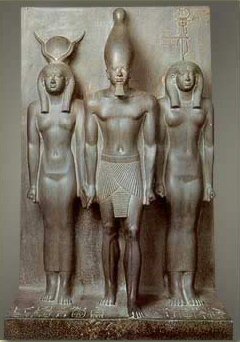
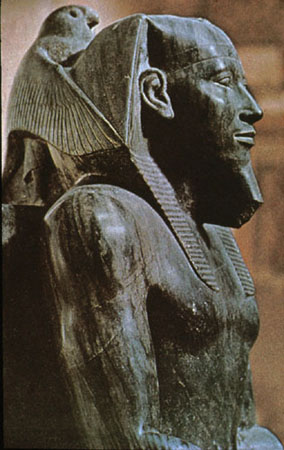
Statues of Menkaure (left) and Khafre (right), both found
in their respective 'Valley temples'.
(Note: Khafre's diorite statue was found buried upside
down).
While there are numerous recorded discoveries of
cartouches and statues of both Khafre and Menkaure at Giza, proof of Khufu's
involvement at Giza is noticeably absent.

Khufu:
This is the only cartouche,
(And therefore the only direct evidence of Khufu's involvement with the
Great pyraimd).
This cartouche (right), was found on the southern roof
blocks of Campbell's chamber in the 'Great' pyramid, as was another
cartouche which is translated as 'Khnum-Khuf', found on the
south wall of 'Lady Arbuthnot's' chamber
(10). The same
two Hieroglyphs have been found alongside each other elsewhere in Egypt. A
situation which has generated speculation over their meaning.
Petrie said of this situation: 'The only great
royal inscription (of Khufu) is on the rocks of Sinai. There are two
tablets: one with the name and titles of Khufu, the other with the king
smiting an enemy, and the name Khnum-khufu The name is found in five places
The two names being placed in succession in one inscription cannot be mere
chance variants of the same. Either they must be two distinct and
independent names of one king, or else two separate kings. If they were
separate kings,
Khnum-khuf must have been the most important.
The Oxford History of Ancient Egypt
(1),
states that Khufu's full name was "Khnum-Khufu" which means "The god Khnum
protects me."
However, Fix
(11), pointed
out that while the
'Khnum-Khufu'
inscription occurs more frequently than Khufu's, the name does not appear on
any of the Kings-lists.
Other 4th dynasty finds:
-
In 1955, two dismantled wooden boats were found buried
beside the Great Pyramid beneath stones bearing Djedefre's name (Khafre's
brother).
The sarcophagus and funerary furniture of Queen
Hetepheres I, the mother of Khufu, was discovered in 1925 near the satellite
pyramids of the Great pyramid in shaft G700X of a pit tomb. It was in good
condition and most of the contents were intact. Although the sarcophagus was
sealed, and the canopic jars were intact, Hetepheres' mummy was missing.
These are the oldest examples of canopic jars known.
While there is little debate at present over who built
the pyramids, there is a visible change in the design and quality between
the the first dynasty and the fourth (Such as Flat sided pyramids, Cardinal
orientation, Polar passages, Lack of adornment and funerary
remains). The combination of these particular construction features have no
precedent in Egypt and it is worth looking at the source of the historical
record which suggests an immigration into Egypt at this time of a people as
yet unidentified beyond their title of 'Shepherd Folk'.
The 'Shepherd Folk'..
The sudden and rapid expansion from pre-dynastic Egyptians into the
sophisticated creators of the Ghiza-plateau has been likened to our
modern space program or the computer revolution
(2).
The Greek historian Herodotus passed on what he was told
by Egyptian priests:
The following interpretation adequately describes the
now famous conversation between Herodotus and Manetho. - 'In the course
of his questioning he (Herodotus) encountered one Manetho, an
Egyptian High Priest, scholar and Historian, with whom he conversed at
length thru the agency of an interpreter. Manetho informed his distinguished
guest that the architect of the huge mass of stone was one "Philition", or "Suphis",
of a people known as the "Hyksos", that is "Shepherd Kings". According to
Manetho, the Shepherd Kings were "a people of ignoble race" who came from
some unknown land in the
East; they were a nomadic band who numbered not less than 280,000
souls; they brought with them their families and all mobile possessions,
including vast flocks of sheep and herds of cattle; and they "had the
confidence to invade Egypt, and subdued it without a battle". this same
people, said Manetho, overthrew the then-reigning Dynasty, stamped out
idolatry and endeavoured to firmly establish in the place thereof the
worship of the One true God having completed the Great pyramid, migrated
eastward into the land afterwards known as Judea and founded there the city
of Salem, which later became Jerusalem, the Holy city.'
(12)
(It is noted that although Manetho is a proud Egyptian, he still stated that
the pyramids were built by foreigners).
(... Herodotus
Text cannot be ignored...)
Who were the Shepherd folk?
The following extract is from Seiss
(15) -
'Wilford, in his Asiatic
researches, vol. iii, p.225, give an extract from the
Hindoo records which
seem to support certain factors of Manetho's idea that they were of
'Arabian' origin. The extract says that one Tamo-vasta, a child of
prayer, wise and devout, prayed for certain successes, and that God granted
his requests, and that he came to Egypt with a chosen company, entered it
"without any declaration of war, and began to administer justice among the
people, to give them a specimen of a good king". This Tamo-vasta is
represented in the account as a good king of the powerful people called the Pali. Shepherds, who in ancient times governed the whole country from
the Indus to the mouth of the Ganges, and spread themselves, mainly by
colonization and commerce, very far through Asia, Africa and Europe. They
colonised the coasts of the Persian Gulf and the Sea-Coasts of Arabia,
Palestine, and Africa, and ere the long-haired people called the Berbers in
North Africa. They are likewise called Palestinae, which name has close
affinity with the Philition of Herodotus. These Pali of the Hindoo records
are plainly identical with some of the Joktanic peoples.'
It is noticeable that following the fourth dynasty, all
the 'newly acquired' skills of the previous dynasties appear to become lost.
( More about who built Ghiza)
|
|
The Giza Constructions: An Overview. |
There are nine pyramids visible on the Giza plateau today.
 Several
constructions on the Giza plateau were built under the auspices of the
Fourth dynasty pharaohs Khafre, Khufu and Menkaure. This has been firmly
established through the historical record and subsequent discoveries of
cartouches at the site. However, the discoveries of cartouches and funerary
evidence from earlier dynasties (see above), clearly suggests that parts of
the the site may have been Several
constructions on the Giza plateau were built under the auspices of the
Fourth dynasty pharaohs Khafre, Khufu and Menkaure. This has been firmly
established through the historical record and subsequent discoveries of
cartouches at the site. However, the discoveries of cartouches and funerary
evidence from earlier dynasties (see above), clearly suggests that parts of
the the site may have been
re-used, and it is a reasonable assumption that
some structures were already present at Giza when the large-scale works of
the fourth dynasty began.
The traditional theory is that Giza was built as a funerary
complex for the 4th dynasty pharaohs. However, the lack of contemporary
human funerary remains from
any
Egyptian pyramid
and the obvious astronomical and geometric nature of the site, imply
that the 'pyramids as tombs' theory is no longer sufficient and a broader
definition of both Pyramids and Giza is now required.
While it is true that most of the construction
features at Giza can be seen in the preceding pyramids of the third dynasty,
there are several features which are completely unique.
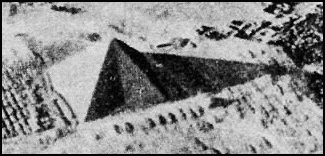
Both the pyramids of Khufu and Menkaure share
the same 'star' shape (left). This design is noticeably absent in the
pyramid of Khafre, central to the whole complex.
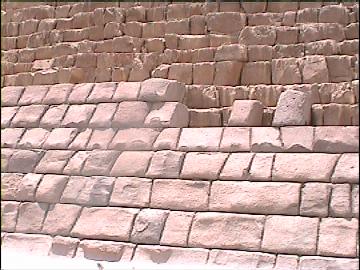
The Flattened surface of the pyramid is seen in
the pyramids of the third dynasty, but nowhere was granite used for the exterior
except for Menkaure's pyramid.
According to Herodotus, this casing of 'Ethiopian stone'
extended for half the height of the pyramid.
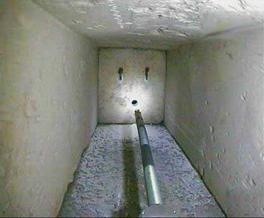
The so called 'Star-shafts' are unique in any
Egyptian structure before or after. Their purpose is still only speculative. The
two shafts from the 'Queens' chamber were built in place with their ends
unfinished, and therefore invisible. The upper ends of the shafts terminate with
'doors' which have so far only yielded controversy.
(More about the 'star-shafts')
|
The 'Great' pyramid of Khufu (Cheops, Shoufu) - Son of Snoferu.

Khufu's pyramid official name was 'Khufu
belongs to the horizon': The exterior angle of Khufu's pyramid is 51�
51', which in geometric terms is (360/7) x 4. This same angle is seen in the
angle of the avenue leading from
Stonehenge, and the angle
from Avebury
to the 'Sanctuary'.
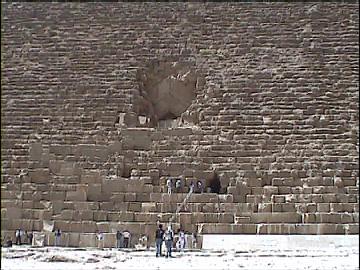
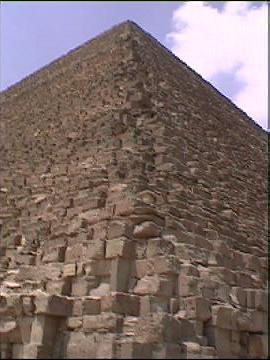
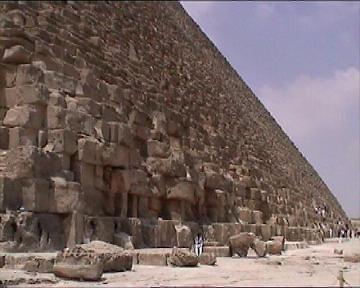
Very few photos do justice to the
mountainous effect of the pyramids.
The Giza pyramids were all built with
simple horizontal rows of blocks - In the case of the great pyramid an
estimated 2,500,000 with an average weight of 2.5 tons each. The
pyramidion or Ben-ben
is missing from the top and has never been reported.

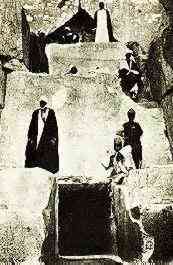
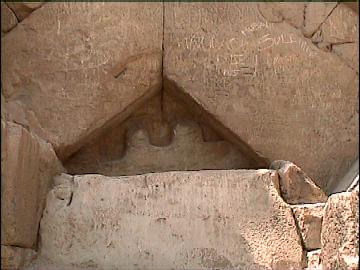
The 'original' entrance:
All of these stones were hidden in its original form. The original
entrance was reported as having a pivoting stone similar to those found at
other contemporary pyramids.
(Note the carved symbol over the lintel is said to represent 'The
infinite horizon').
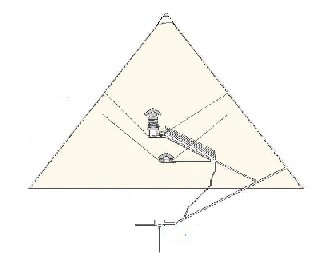
Internal Features:
(Architectural Analysis of 'Great' Pyramid)
(The
Great Puzzle of Giza):
Full analysis of the Great pyramid: When, Why, Who, How.. etc etc.
|
|
The pyramid of Khafre (Chephren) - Son of Khufu.
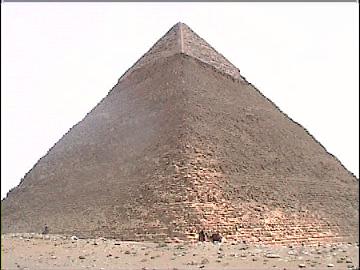
Khafre's
pyramid stands equal in height to the great pyramid, although it is actually
smaller - this is due to its being built on higher ground.
The angle of slope for 'Khafre's' pyramid is
achieved as a result of a 3:4:5 triangle. (As is the King's coffer in the
Great pyramid).
Although the majority of books discuss the
'mysteries' surrounding the 'great' pyramid, Khafre's has certain
features that make it equally unique. Not only does it sit at the geometric
centre of the site, it is also attached to the Sphinx by a causeway,
although this causeway runs over other tombs suggesting it was a later addition.


Khafre's pyramid sits at the centre
of the Giza plateau, it is attached to the
Sphinx
by a causeway, the angle of which is 30� off true East.
|
|
The Pyramid of Menkaure - Son of Khafre, Grandson of Khufu.

Although
Menkaure's pyramid is the smallest, and was constructed last, it was faced
with several layers of granite, which were left unfinished.
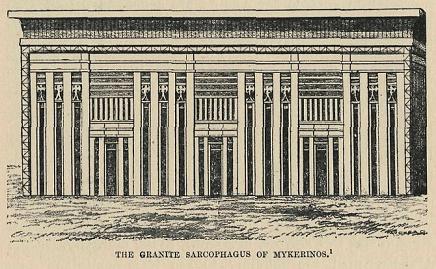
The blue basalt coffer which
was taken from the pyramid was lost at sea a year later in 1838. A joint
Egyptian/Spanish initiative is currently underway to retrieve it.
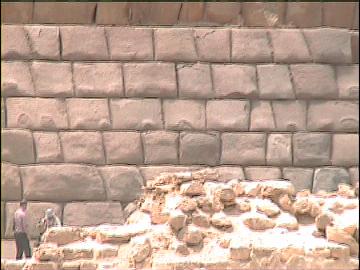

Menkures Granite Facing Blocks.
(Note - The very specific 'protuberances' on
the granite blocks seen on the Menkaure pyramid are a common
architectural feature in seen in both
Abydoss, and in
S. America).
(Similar
construction techniques from the ancient world)
|
|
Levelling the Giza Plateau: |
Before the pyramids were built, the whole Giza plateau
was first levelled, then covered with a vast limestone pavement...
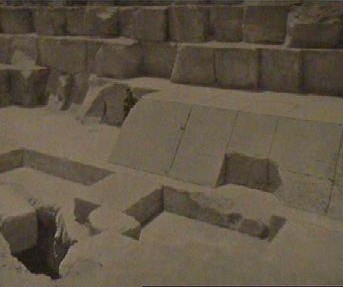
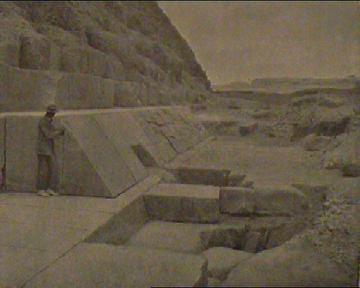
Large holes under the pavement. (North face:
'Watchtower', 1910)
The Giza plateau is composed of limestone which is
characterised by naturally eroded cavities.
(More about the
Underground Cavities and Tunnels at Giza)
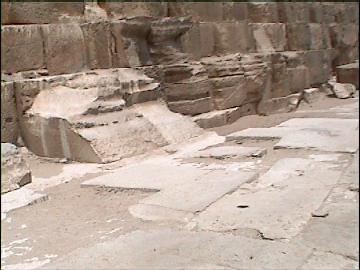

The huge paving slabs can be seen to run under
the Khufu's pyramid.
Note the visible difference in erosion between
the exposed casing stones (above left) and those uncovered last century
(above right). The section on the right, has been significantly 'restored'
since 1910 (See photo above).

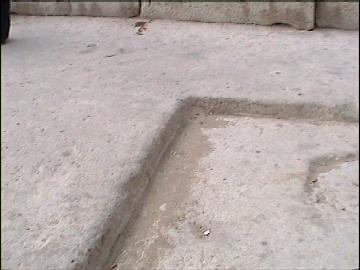
The bedrock of the whole plateau was carved to
fit individual stones.
This technique was probably included to
provide a preventative against movement but also created a surface that was
accurate to within optical standards.
In 'The Great Pyramid Decoded, Peter
Lemesurier writes, "It would be a rash man who undertook to find,
even today, a building more accurately aligned to the True cardinal
points of the compass, masonry more finely jointed, or facing-stones
more immaculately dressed.... the sceptic may doubt that many of the
pyramid's stones -- some of them weighing up to seventy tons -- were
so finely cut and positioned as to give joints of less than a
fiftieth of an inch in thickness'; '...he may scoff at the claim
that a fine cement was run into these joints so expertly as to give
an even coverage of single areas as big as five feet by seven in
the vertical; he may express profound disbelief when it is
pointed out to him that the building's now almost totally despoiled
original outer casing of polished limestone (all twenty-one acres of
it) was levelled and honed to the standard of accuracy normal in
modern optical work. But these, as it happens, are facts which
anybody may check who cares to'.
Certain sections of the
pavement were built with a contrasting black basalt.
(Petrie's Original
Diagram of the Pavement)
.jpg)
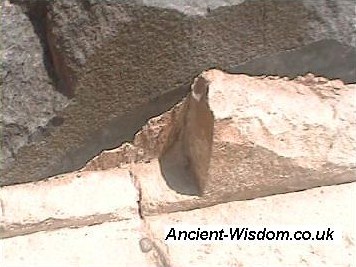
The seam between the
basalt and the limestone pavements.
(It looks very much as if 'concrete'
or 'cement' was used between basalt rocks).
(Other examples of
concrete in prehistoric structures)
This superb
structure is without comparison at Giza. It has no other
contemporaneous building in Egypt except perhaps the
Osireion at Abydoss (Which shows
stark similarities).
The causeway that leads from Khafre's pyramid leads to the Sphinx on
one side, and the Valley temple on the other. The valley temple was
constructed with immense blocks of granite, surrounded by a wall of
even larger blocks of limestone, the largest estimated to weigh
approximately 200 tons.
(The largest cut-stones ever)

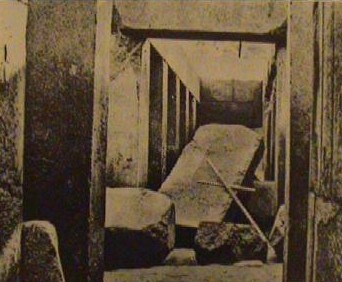
Early shots of the Valley temple.
Note the height of the surrounding limestone casing-stones in the photo
(above, left).
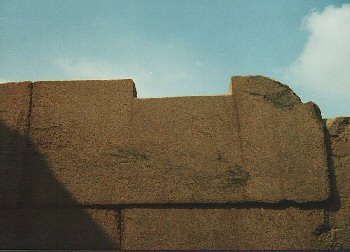
The light-slots running
along the top of the Valley-temple are believed to have allowed light to
enter at particular times.

The granite masonry of the valley temple is
reminiscent of S. American architecture.
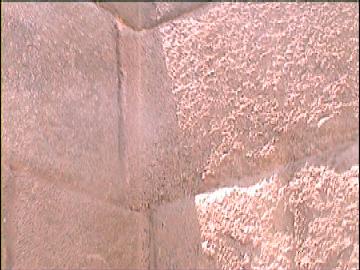
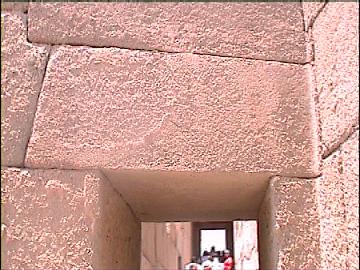
As are the multi-facetted stones and the
way they were carved to 'fold' around corners.
(Similar construction techniques from
around the ancient world).
The 'Osireion' and the 'Valley Temple':
Are they contemporary structures?
It has been suggested that the Osireion
and the Valley temple at Ghiza are contemporary structures. There are
several factors which indicate that this may be the case, which would
make the Osireion a 4th dynasty structure
The two buildings
are similar in design and appearance.


Both structures are made from
large, square, unadorned lintelled pillars. Two rows with five
pillars in each, run along the central chamber. Both structures
were covered over, and both were associated with the Nile.
Of particular
interest is the early-dynastic history of the unification of
'upper' and 'lower' Egypt and the primal Egyptian myth of Osiris
and Isis, in relation to these temples. These temples
suggest a commonality, whilst adhering to the theme of the
Isis/Osiris myths. The Osireion is associated with Osiris, and
the Valley temple to Isis, his consort, sister and mother. The
Ghiza pyramids are cardinally orientated (equinoxially), while
the great temples in the south of Egypt such as Karnack,
Denderra and The Temple of Seti (Osireion), are orientated to
the solstices. The symbolic act of unification, was not only
concerned with the physical boundaries of Egypt, but
also the solar year.
Both Ghiza and
the Osireion show the same techniques of masonry suggesting a
contemporary construction.


The same 'manouvering
protruberances' were left on the otherwise finished blocks of
Menkaure's pyramid.
(More about the Osireion)
| The
Geometry of the Giza pyramids: |
Disregarding the implausibility of pure coincidence, there are several basic
geometric associations within the dimensions of the pyramid structures that
make it hard to ignore the idea that they were
not built from an original geometric design.
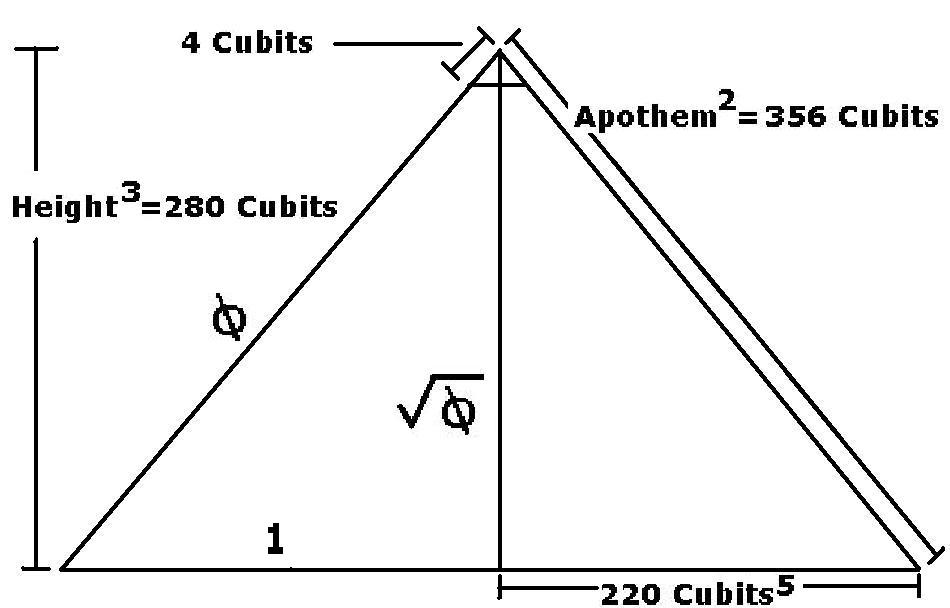
The geometry of the 'Great' pyramid's exterior dimensions.
Herodotus (440 BC), recorded that Egyptian priests told him then that the
Great pyramid was designed so that the area of each face was equal to the
square of its height.
This means that the designers incorporated Pi (∏) , and Phi (Ф) in the
following fashion.
(Apothem - 1/2 base = 1.6181 (Ф), and
Height x 2∏ = Perimeter)
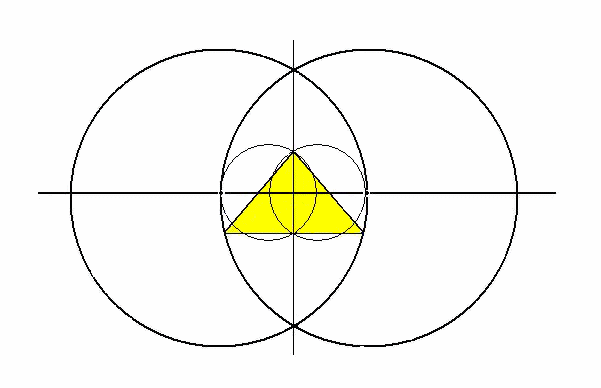
The exterior angle of the great pyramid can be formed with
the vesica-pisces.
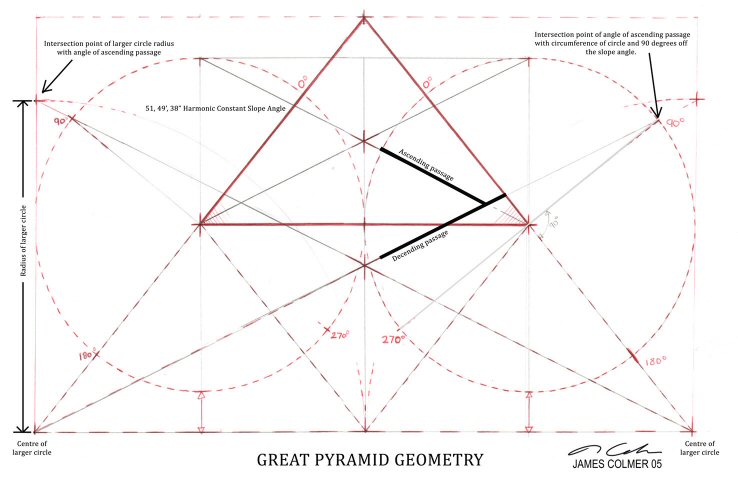
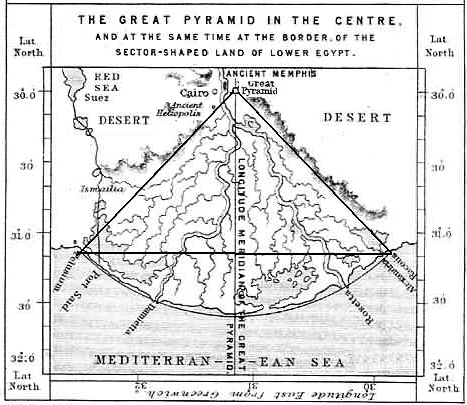
The angle of the Great pyramid extend to the borders of
the Nile Delta.

It is a fact (whether through accident or design), that
the dimensions of the Great pyramid form an accurate representation of the
northern hemisphere of earth.
Internal Geometry of the Great pyramid.
The 'Kings' Chamber:
The walls of the chamber are composed of five rows with twenty
blocks on each. No two blocks have the same dimensions.
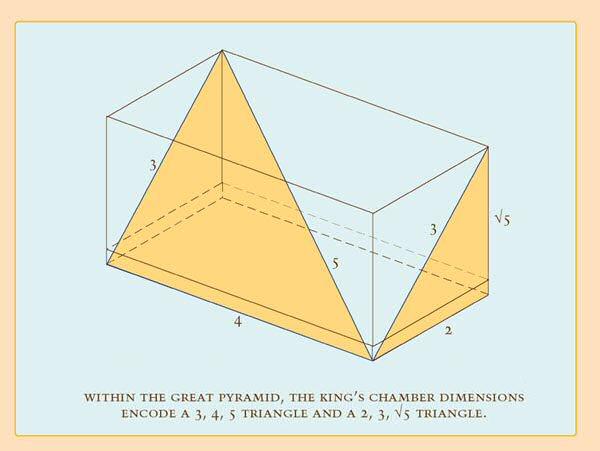
The 'King's' Coffer:
The 'kings coffer' in Khufu's pyramid also shows very specific
geometry in its dimensions. Not only is
the
volume of the interior equal to half the Volume
of the exterior, but
the coffer's interior
dimensions also demonstrate the application of a 3:4:5 triangle -
demonstrating the means for creating the angle of slope for Khafre's
pyramid).
| Description |
Width |
Height |
Length |
Volume |
| Coffer (inner)
- (cubic inches) |
26.8 |
34.4 |
78.1 |
72,002 |
| Coffer (outer)
- (cubic inches) |
38.5 |
41.3 |
89.6 |
142,46 |
The Giza pyramids also share simple geometric relationships between
themselves.

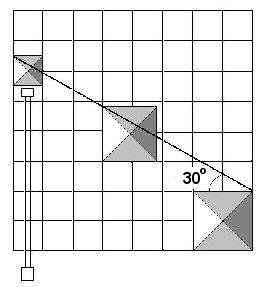
The layout of the pyramids reveals
the application of the 'sacred mean' - a 5:8 ratio.
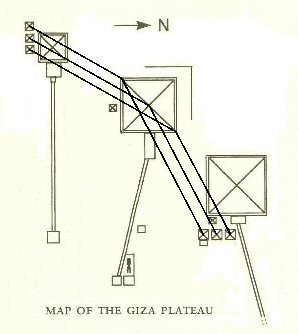
Geometry connects the 'satellite' pyramids.
And extends beyond Giza itself...
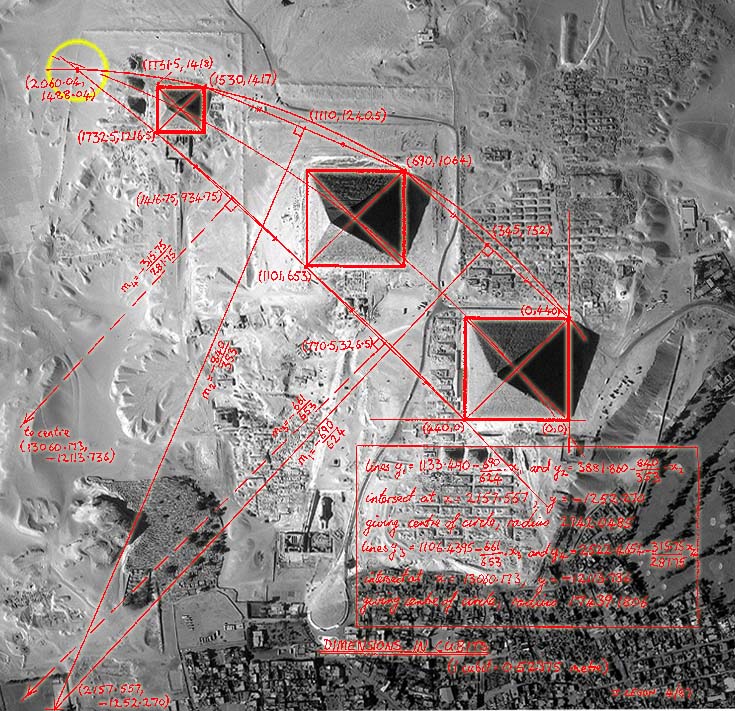

The Geodetic/Geometric Connection between
Giza and Stonehenge.
It has been
frequently suggested in the past that there is a connection
between the two sites, an idea which archaeologists and
historians have (reasonable) difficulty accepting. One of
the primary observations has been that the latitude of
Stonehenge is the same as the exterior angle of the great
pyramid of Khufu. In itself of course, this is not enough to
substantiate such a theory but when one looks closer at the
two sites, other geometric/geodetic facts emerge which
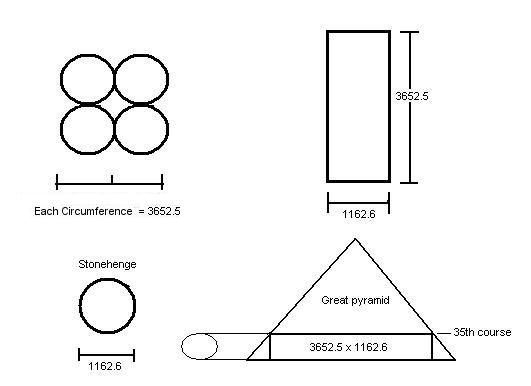
It was noticed by Petrie that the constructional diameter
of
Stonehenge was derived
from the Egyptian unit of measurement called the aroura,
the original representation of which was also in the shape
of a circle. The circumference of the Egyptian aroura
measured 3652.42 units of length with each ten units
representing a single solar day (resulting in a diameter of
1162.6 units of length). The aroura was subsequently
divided into four equal parts called quarter aroura�s
of which a circle of equal area is made by the stones at the
same time as defining by alignment, the points and circuit
of the solar year�. A similar association was held between
the quarter aroura and the solar year in ancient
Egypt. For as Horapollo states:
To represent the current year, they (the Egyptians) depict
the fourth part of an aroura�in the Egyptian Hieroglyphic
representations for the year � one indicated by a square and
the other by a circle.(3)
It is interesting to note that Petrie determined that the
base circuit of the great pyramid measures 36,524 P
inches, and that the 35th course, being the
course with the largest blocks was laid at a height of
1162.6 P inches, and has a square circuit of 29,220 P
inches (The same amount of years for Gods and kings to
Amasis II : From Eusibius).

The exterior angle of Khufu's pyramid is 51� 51', which in
geometric terms is (360/7) x 4 or ( 4/7th
of 90�), which is a highly significant figure as it is the same latitude as
Silbury hill, Europe's largest
stepped pyramid (c. 3,000 BC), which itself has an exterior angle of 30�
(The same latitude as Giza). The same angle is repeated at
the avenue leading
from
Stonehenge, and the angle
from Avebury
to the 'Sanctuary'.

The exterior angle of Khafre's pyramid is
53� 10', which is
(almost exactly) angle formed by a 3:4:5 triangle. Khafre's pyramid is attached to the
Sphinx via a causeway that runs 30� off true East. The exterior angle of
Khafre's pyramid is the same as the latitude of
Arbor Low, which sits exactly 2� north of Stonehenge.
(Egyptian
Geodesy) (English
Geodesy)
(Geodesy
Homepage)
|
Alignments Between Pyramid Corners.
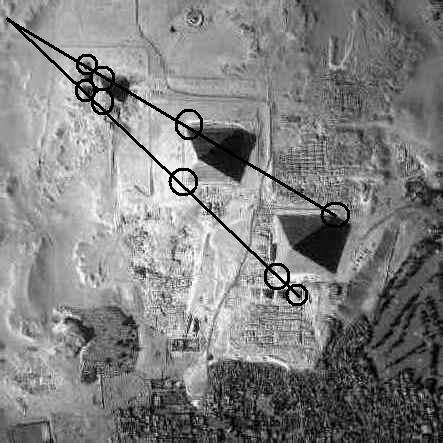
The
Giza pyramids show clear corner-alignments between each other.
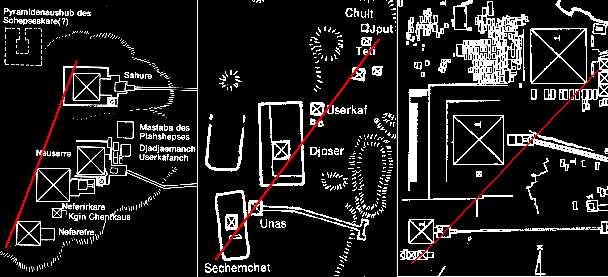
The same alignment of corners has been noticed at other 'Heliopean'
pyramids.
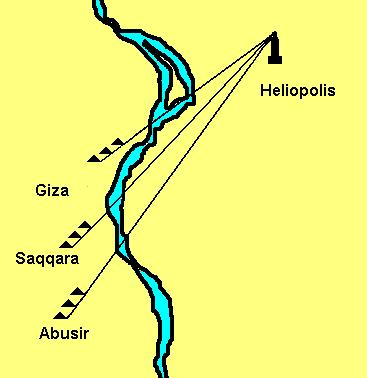
The corners of many 4th and 5th dynasty pyramids align to
Heliopolis.
( More about the Alignments of Pyramid Corners)
|
|
Astronomy at the Giza Plateau; |
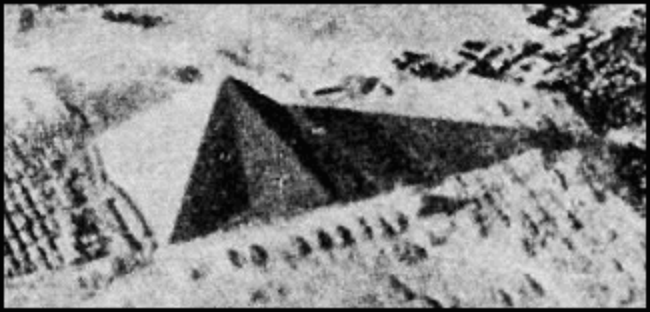
Apart from the obvious evidences of astronomy in
the 'Polar' passages of the pyramids and the orientation of
the Sphinx, Giza
demonstrates several other instances of astronomical influences at
the time of construction.
It is a well known fact that
the N/S axis of the Khufu (Cheops) is only 03' 06" to the west of
true north, a fact which confirms the levels of skill/accuracy
attained by the ancient Egyptian astronomers
(and builders).
It has been noted that (Through accident or design),
the
Great pyramid of
Giza
is a particularly accurate scale model (1:43,200),
of the Earth's dimensions.

The number 43,200 is a specific 'precessionary'
number, one of several that are repeated in Egyptian myth, text and
construction.
The Precessionary
cycle lasts approximately 25,920 years, which results in a new constellation
appearing on the horizon each 2,160 years....
and 2,160 x 2 =
4,320 years.
(More about
Precession)
The Giza plateau was built on the
30th latitude.
It seems unlikely that
when combined with the other specific geometric and astronomic figures in
the dimensions at Giza, that the site was chosen for its latitude
accidentally. The same latitude was chosen by the Persians (Persopolis), The
Sumerians, (Larsa), and the Tibetans (Lhasa) for their sacred centres.
|
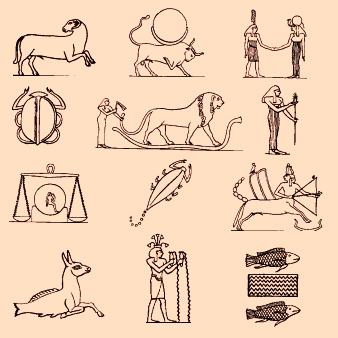
The original Egyptian zodiac.
|
The Astronomical significance of the three small pyramids next to
Khufu's pyramid.
In the common
opinion of Egyptologists, the small pyramids next to the great
pyramid of Khufu served as burial places for the relatives of the
Pharaoh. Certain facts, which have not been previously considered,
indicate that there is a chance that the pyramids � due to their
ground plan arrangement � are not only burial places but also the
components of a yearly calendar. Research by the Hungarian architect
Andr�s
G�czey has demonstrated that there are clear alignments between
Khufu's pyramid and the three smaller burial pyramids of his
relatives. The Basic Principles of the 'Khufu Calendar' are as
follows:
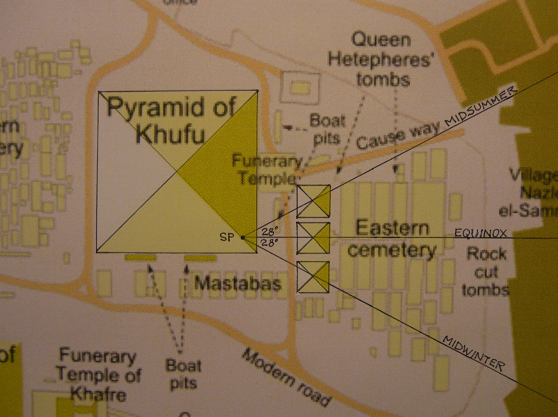
(The Great Puzzle of Giza - A Complete
Analysis of The Great Pyramid)
(Beneath Giza:
A Review of the Facts)
(Egyptian Geodesy)
(Extreme Egyptian Masonry)
(Egyptian Astronomy)
(Pyramids Homepage)
(Other Egyptian Sites)
|




























.jpg)





























